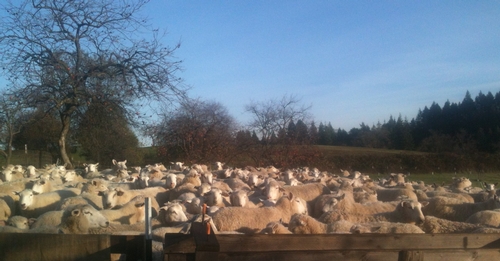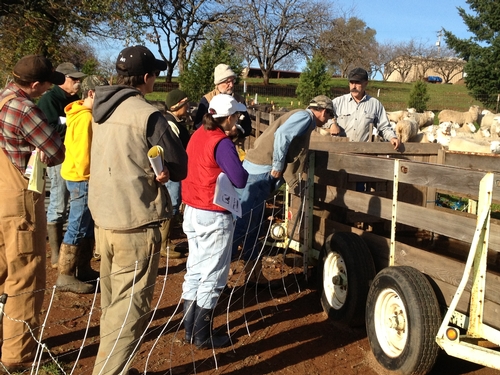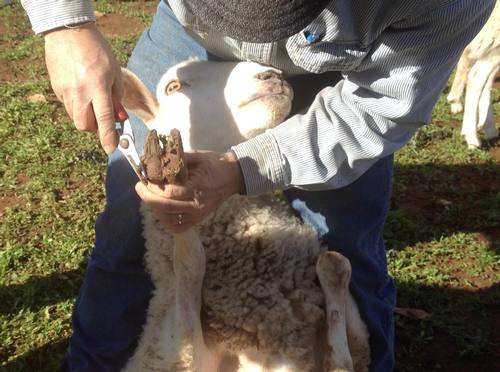Foothill Farming Blog
Pasture Lambing Workshop
Join UCCE and Flying Mule Farm for a 3-hour pasture lambing workshop in Auburn, California, on March 10, 2013. The workshop runs from 9 a.m. until 12 noon. You'll get hands-on experience in caring for newborn lambs, handling ewes and lambs, pasture management, and health issues. For more information, go to http://ucanr.edu/sites/placernevadasmallfarms/?calitem=177214&g=22527.
Marketing Academy on February 15th and 16th
On Friday and Saturday, the 15th and 16th of February, the UC Cooperative extension here in Auburn will be hosting a Marketing Academy which will cover topics ranging from increasing sales at farmers’ markets, to learning about wholesale marketing.
The first workshop (Friday, February 15th, 1-4 PM) will focus on using health and nutritional information as marketing tools to help boost product sales. In the past several months, we at UCCE have been producing nutritional cards for various crops, and distributing them when we do tastings at farmers’ markets. We have seen a tremendous response to this type of marketing and education, and want to ensure that farmers learn about this process and how to incorporate it into their sales operations.
We will kick off Saturday, February 16th (8-Noon), with a workshop about increasing sales at farmers markets. So much of this has to do with relationship building, creating a visually appealing stall, and, of course, brining your best product to market. Most farm operations can always do better in one or more of these aspects, and many farms can improve in all three. This workshop will give practical tips and tricks to help boost those sales.
To conclude the Marketing Academy, on Saturday the 16th (1-5PM), we will have a workshop entitled “How to Break into Wholesale.” This workshop will provide information for growers new to wholesale, as well as for those with some experience with wholesale sales. Farmers markets, as we all know, each have a limit in the volume of sales. Wholesale venues give access to larger markets and the potential for a greater volume of sales. For some operations, wholesale marketing is the key to becoming financially viable. At this workshop, farmers will learn the “ins and outs” of selling to several wholesale buyers, who range from a small local grocery store, to a wholesale distributor.
The importance of marketing in a farming operation should not be understated. Any farm depends as much upon production as it does upon marketing. From choosing an appropriate display for a farmers’ market, to deciding whether or not to engage in wholesale marketing, these decisions have profound effects on the viability of a farming operation.
Come and learn more about marketing and ways to improve your strategies for the impending farming year. For more information and to register for these workshops, click here: http://ucanr.org/sites/placernevadasmallfarms/?calitem=180483&g=22527
Your Hand is Not a Hammer
Winter seems to drag on forever, doesn’t it? In October I can’t wait for winter. I am tired of being hot and sweaty. I am tired of eating tomatoes. All I really want to do is eat leafy greens, stay inside by the fire, and read a good book. Now that it is January. I am tired of leafy greens and long for a tomato. The reading by the fire part I am still enjoying. I won’t say I have spring fever, but I am definitely feeling the call of the land.
This happens every year in January. I can feel a certain buzz throughout my body that I can still only by doing something farmy. What is a farmer to do when the weather does not allow outdoor farmy activities? I do a couple of things to calm my inner worker bee. The first thing I do is I plant tomato seeds. I plant more than just tomatoes. I plant all sorts of things: peppers, eggplant, celeriac, and broccoli raab. I have to keep myself under control because more than once I have started seeds too early, only to have the plants ready well before the soil is dry enough to work up for planting. Seedlings that are over mature at planting time never reach their true potential. So it is better to wait a few weeks rather than grow a bunch of plants you should never plant in the first place.
The second thing I do is make sure all my equipment is ready to go. I want to be able to capitalize on weather breaks and work up some ground, and maybe even plant some things like carrots, beets, or lettuce. I change the oil in all the tractors and do whatever the owners’ manual says in terms of lubrication and adjustments. Once the tractors are done I start working on the implements I attach to the tractor. I always start with the tools that have a gear box, like mowers and tillers. I check all the fluid levels and replace the fluids if the manual tells me to. I like to adjust the drive chains on the tiller, and January is a good time to replace any worn out leaky gaskets. This year I get the fun job of replacing all the tines on both of my tillers. (Actually, this is not fun.) If you have ever had to replace tiller tines you know what I mean. I have 72 rusted bolts just waiting to frustrate me. Hello, liquid wrench.
While I am talking tools I should pass on two items of farm wisdom that I always find valuable. The first one is: grease is your friend on the farm. The second is: your hand is not a hammer. I was told these gems by an excellent farm mechanic, and I do my best to take them to heart. Whenever I use a piece of farm equipment I grease it first and when I need to beat on something I try to find the appropriate beating tool and preserve the integrity of my hand. This is especially true when working with wrenches to loosen stubborn nuts and bolts. Use a mallet to tap on that wrench not the palm of your hand that is unless you really want to have carpel tunnel syndrome.
Every tool in the farmer’s and gardener’s tool shed needs a little love once in a while, so take the time this winter to oil all your wooden tool handles with linseed oil and make sure you sharpen all those hoe blades. Spring is coming and so are the pig-weed, lamb’s quarter, and whatever other weeds you have that make you crazy. Sharp tools will make the job of killing all those weeds easier and faster. The sun is shining, but the soil is cold so get out to your tractor shed and tool shed and do a little work on your tools so you are ready to go once planting season gets here.
Building a Tool: discoveries along the way
First of all, it’s not your typical farm tool. It isn’t a hoe, or a shovel, or even a tractor implement. But, it may help you harvest faster, increase your production, and lead to greater profits. By now, with the dawn of agriculture some 12,000 years or so behind us, it is reasonable to believe that every tool we really need has already been invented. Of course, there can never be enough variations of the hoe in the minds of the tool manufacturers. However, during the past several months, I have noticed a gap in the pantheon of farm tools.
The type of tool I’m talking about is a financial tool. Try though I may, I just cannot find a tool for small-scale farmers that help them address costs of production, profit margins, gross margin ratios, and other metrics in an accessible, comprehensive, and (this last part is very important) farmer-friendly manner. If I am remiss in my search, please let me know ASAP. However, I suspect that I am not. I have come across many books that either over-simplify this process, or address important accounting/book-keeping concepts while leaving out a comprehensive analysis of the operation in a (again, very important) farmer-friendly format.
In plain terms, here’s what I find lacking. Every small-scale farming operation here in Placer and Nevada Counties produces more than one crop. For an operation that produces one crop, it is very easy to get at the costs of production, profit margin, gross margin ratio, etc for that particular crop. However, when the farm starts to add crops to that list, the challenge of isolating these metrics becomes increasingly complicated. Any literature about this tries to address the problem by presuming that these crops exist by themselves, as if they were a one-crop operation. They do not.
In short, I seek to create a tool that can generate various metrics for a given crop, in the broader context of the operation as a whole. Translation: I am building a tool that will allow a farmer to know metrics for their carrots, beets, lettuce, broccoli, and whatever else they grow. I feel it’s a necessary step for farmers to be able to run a profitable business, and thus continue to farm.
Why is this important? Well, farmers may be selling their crop under their costs of production. For instance, through this process, I learned that for several years I was wholesaling bunched carrots for less than it took me to get them to market. Ouch. Maybe that’s why I was not hitting my salary goals! How many farmers are like me? Perhaps none. Perhaps several. Yet, I would guess the answer is that most farmers have this issue.
If you are a farmer, I recommend that you not be afraid of your numbers. Every little bit will help you and your business to succeed, and knowing your numbers may give you a measure of control in an otherwise unpredictable industry.
10,000 Hours of Farming
In his book Outliers: The Story of Success, Malcom Gladwell writes that, “To become a chess grandmaster also seems to take about ten years. (Only the legendary Bobby Fisher got to that elite level in less than that amount of time: it took him nine years.) And what’s ten years? Well, it’s roughly how long it takes to put in ten thousand hours of hard practice. Ten thousand hours is the magic number of greatness.” While Gladwell is discussing outliers – those individuals in specific professions that stand head-and-shoulders above their peers, I think the “10,000 Hour” rule applies to many activities, including – in my case – sheep farming.
I don’t claim to be an expert shepherd – I’m often humbled by the realization of how much I don’t know about raising sheep. However, I estimate that since I started raising sheep on a commercial scale in 2006, I’ve spent in the neighborhood of 14,000 hours doing everything from moving portable electric fence to trimming hooves to analyzing the economics of my business. And while I still have more questions than answers about how to make my living by raising sheep, there are parts of this business that are far easier now that I’ve invested so much time!
Some of the benefit is akin to muscle memory. If you repeat a physical motion enough times – like playing the piano – eventually your muscles remember where to place your limbs and digits. These movements become second nature. Last week, we completed our annual task of trimming feet, a process that involves tipping every ewe onto her backside and trimming all four of her hooves. With 250 +/- sheep, this meant trimming approximately 1,000 feet! Just 5 years ago, such a task would have left my back sore for several days – and it would have taken three people just to treat our flock of 100 ewes in a single day. Last week, with help from a few friends, we treated 250 animals in about 8 hours.
Building electro-net fencing is another example of increasing efficiency. I estimate that I put up and take down my 164-foot rolls of electro-net between 700 and 800 times in a year. When I started learning how to use the fencing 7 years ago, a 6-net paddock (which encloses about 1.25 acres) took me several hours. Two weeks ago, I built a 16-net paddock (enclosing 9.25 acres) in less than three hours. Once again, I’ve now built enough fence that I learned how to be as efficient as possible.
Some of the benefit of putting in the hours comes from learning from experience and knowing what to expect in certain situations. When we first started using livestock guardian dogs to protect our sheep from predators, I was always extremely worried when a dog got out of my pastures. Typically, I’d drop everything else I was doing and try to catch the dog. To my dogs, this became a great game – I could almost see them thinking, “let’s see how long he’ll follow me!” The dogs would eventually decide to come back on their own, but it took me several years to realize this fact. Last month, one of the dogs got out while I was sorting our rams from our ewes in a pasture. Rather than put the already-separated rams back with the ewes and track down the dog, I continued with my task. By the time I’d sorted the last ram from the flock, the dog had returned from his jaunt and was ready to be back with his sheep. I realize that this story doesn’t sound like much – after all, it only saved me 30 minutes of not chasing the dog all over the ranch. However, I find that each time I can apply my accumulated experience and knowledge I save myself (and my animals) time and stress – and these savings add up like compounding interest!
Finally, spending time working on the business is as important as spending time working in the business. When I’m working “in” the business, I’m doing many of the things I’ve discussed above. When I’m working “on” the business, I’m thinking about bigger questions – how should I market my lambs next year, for example. I’ll admit I’d much rather spend the day working with my sheep than in front of my computer, but I find that the quality of my “on-the-business” work improves the more I do it as well. For instance, we’ve decided this year to keep our sheep year-round on properties much closer to home, which will reduce our overhead costs substantially. We’ve adjusted the scale of our operation to fit the land we can access without putting the sheep on a trailer.
I suppose that this idea is at least indirectly related to scale. The more sheep you raise – or the more carrots you grow – the more quickly you cross the 10,000-hour threshold. Regardless of size, however, the investment of time in farming eventually pays dividends in skill level (and hopefully in profitability).
The purpose of these stories is not to brag about my prowess as a shepherd but rather to illustrate that there is no substitute for putting in the time as farmers. While I believe strongly in the power of planning and analysis, at some point we all have to implement our plans – we have to farm! If we’re observant – and humble enough to learn from our mistakes – this investment of time will pay off. While 10,000 hours of working with sheep won’t make me as famous (or as wealthy) as Buster Posey (the Giants MVP catcher for you non-baseball fans) it will make me a better farmer!




